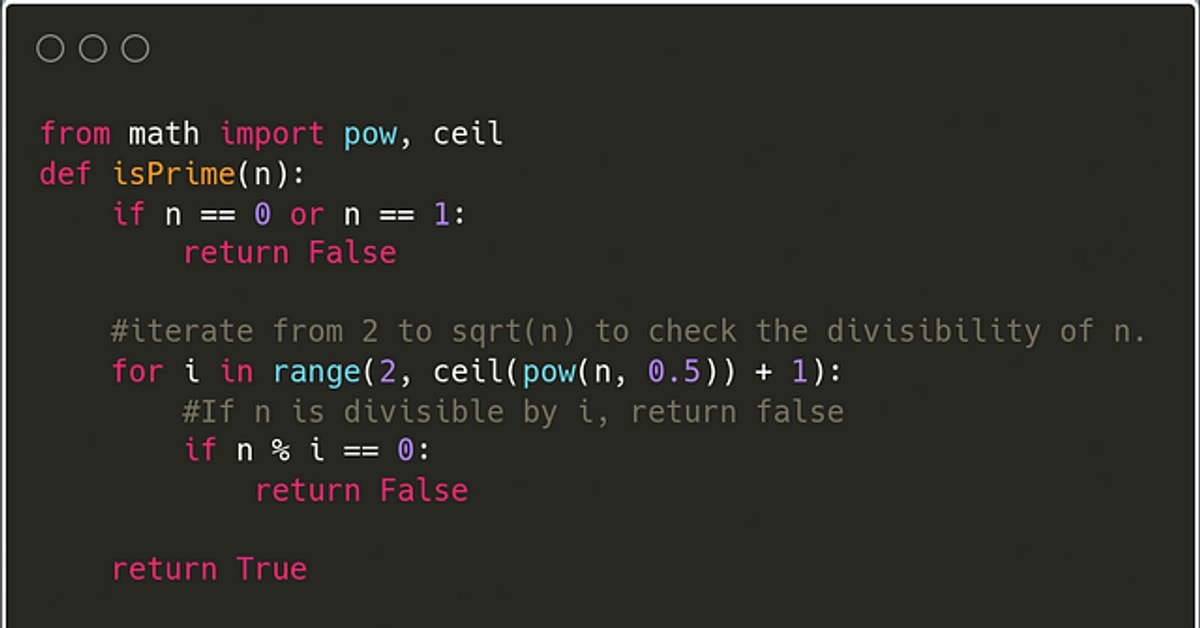Article Body
A prime number is a number that is greater than 1 and has no divisors other than 1 and itself. In this article, you will learn how to write a Python program to check whether a number is prime or not, and we'll explain everything in a simple way.
🔢 What is a Prime Number?
A prime number has only two factors:
-
1
-
The number itself
📌 Examples of prime numbers:
-
2, 3, 5, 7, 11, 13, 17, 19...
📌 Examples of non-prime (composite) numbers:
-
4 (divisible by 2), 6 (divisible by 2 and 3), 9 (divisible by 3)
💻 Python Program to Check Prime Number
Here’s a simple and clean Python program:
# Program to check if a number is prime
# Step 1: Take input from the user
num = int(input("Enter a number: "))
# Step 2: Check if the number is less than or equal to 1
if num <= 1:
print(num, "is not a prime number")
else:
# Step 3: Use a loop to check for factors
is_prime = True
for i in range(2, int(num ** 0.5) + 1):
if num % i == 0:
is_prime = False
break
# Step 4: Print the result
if is_prime:
print(num, "is a prime number")
else:
print(num, "is not a prime number")
🧾 Step-by-Step Explanation of the Code
✅ Step 1: Take User Input
num = int(input("Enter a number: "))
-
We use
input()to ask the user to enter a number. -
int()converts the input from a string to an integer.
✅ Step 2: Check for Edge Cases
if num <= 1:
print(num, "is not a prime number")
-
A number less than or equal to 1 is not prime (e.g., 0, -5, 1).
-
We handle this before doing any further checks.
✅ Step 3: Check for Factors Using Loop
is_prime = True
for i in range(2, int(num ** 0.5) + 1):
if num % i == 0:
is_prime = False
break
How does this work?
-
We assume the number is prime with
is_prime = True. -
We check all numbers from 2 to square root of
num.-
Why square root? Because if a number has a factor greater than its square root, it must also have a smaller factor. This reduces the number of checks.
-
-
If we find any number that divides
numevenly (num % i == 0), we know it's not a prime.
✅ Step 4: Show the Result
if is_prime:
print(num, "is a prime number")
else:
print(num, "is not a prime number")
-
Based on our loop, we print the final result to the user.
-
Based on our loop, we print the final result to the user.
✅ Example Output
Enter a number: 7
7 is a prime number
Enter a number: 10
10 is not a prime number
🤔 What If We Don’t Use Square Root Optimization?
If we check up to num - 1, the program will still work, but it will be slower, especially for large numbers.
This is the less efficient way:
for i in range(2, num):
if num % i == 0:
is_prime = False
break
📌 Use the square root method for better performance.
✅ Bonus: Create a Function to Check Prime
You can also make a reusable function to check if a number is prime:
def is_prime(n):
if n <= 1:
return False
for i in range(2, int(n ** 0.5) + 1):
if n % i == 0:
return False
return True
# Test the function
num = int(input("Enter a number: "))
if is_prime(num):
print(num, "is a prime number")
else:
print(num, "is not a prime number")
This way, you can reuse the is_prime() function in other programs.
📚 Summary
-
A prime number has only two divisors: 1 and itself.
-
We use a for loop to check if the number has any other divisors.
-
Using square root optimization improves performance.
-
We can also turn the code into a function for reusability.
🙋♂️ Frequently Asked Questions
🔸 Is 1 a prime number?
No, by definition, 1 is not a prime number.
🔸 Why check up to the square root?
Because if a number has a factor greater than its square root, the matching pair factor must be smaller.
🔸 What is the smallest prime number?
The smallest prime number is 2. It is also the only even prime number.


Comments